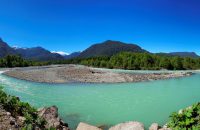Río Gallegos is the Argentinian mainland’s most southerly city. Although frequently overlooked in favor of the Fuegan town of Ushuaia, Río Gallegos has plenty to offer – especially if you’re looking for something a bit less touristy. So, whether you’re passing through or using the city as your base, Río Gallegos is a quaint, low-key yet entertaining option. So, without further ado – here are our top five things to do in Río Gallegos.
1. See Cabo Vígenes’ Magellanic penguins

Perhaps one of the greatest benefits of visiting a town that’s less geared to tourists is the alone time you can get with Patagonia’s spectacular wildlife. Río Gallegos is near to Cabo Vírgenes, a beach which plays host to a huge colony of Magellanic penguins. During the summer months from December to February, you can see scores of penguins waddling on the shore. Furthermore, to add to the magic, you’re likely to find yourself completely alone on the beach with these adorable creatures.
2. Museo de los Pioneros
For a town of its size, Río Gallegos has a surprising number of interesting museums. One of the best reviewed is the Museo de los Pioneros, which tells the story of the first westerners to arrive in the region. Essentially, the museum is a house preserved in the nineteenth-century style, with interesting objects including clothing, ornaments, and furniture, all arranged exactly as they were in 1900. Additionally, the museum caters to English and Spanish speakers, with information in both languages.
3. Museo Provincial Padre Jesús Molina
If science and nature are more your thing, another museum Río Gallegos has on offer is Museo Provincial Padre Jesús Molina. The museum details the natural history of the area, including displays of fossilized dinosaurs that were excavated nearby. In addition, visitors can also learn more about archaeology, geology, and the indigenous cultures of the surrounding area.
4. Laguna Azul

Laguna Azul is truly other-worldly. Formed in the crater of a dormant volcano, the lagoon is a vivid turquoise. Surrounded by a number of fascinating rock formations created by volcanic activity, any visitor to the area might think they were exploring the surface of another planet. Furthermore, no one is exactly sure how the lagoon formed or how deep it is. Some scientists have suggested it might be connected to an underground spring, originating from the Pacific Ocean.
5. Estancias
A significant part of rural Argentinian culture is ranching. Río Gallegos’ largest export is wool, so the most common type of ranch, or estancia, are sheep farms. The public is free to roam on these huge estates, spotting wildlife and enjoying the landscape. Depending on the time of year, some estancias offer food, accommodation and excursions – check ahead to make sure the estancia you intend to stop by is open.
Río Gallegos: A road less traveled
So, if you’re looking for a city on your Patagonian adventure that offers something a little different, Río Gallegos is a great choice. With local wildlife attractions, nature and museums, this southerly city is the perfect pit stop or hiking base.
No comments yet
There are no comments on this post yet.






Leave a comment